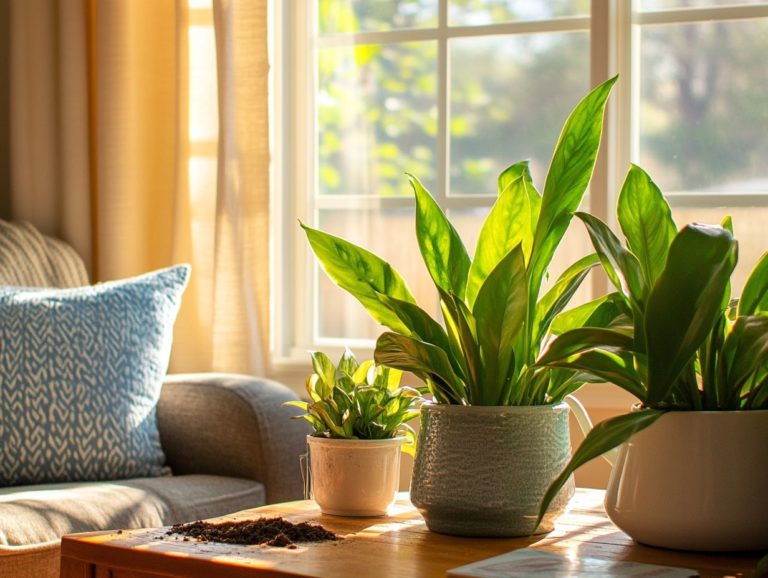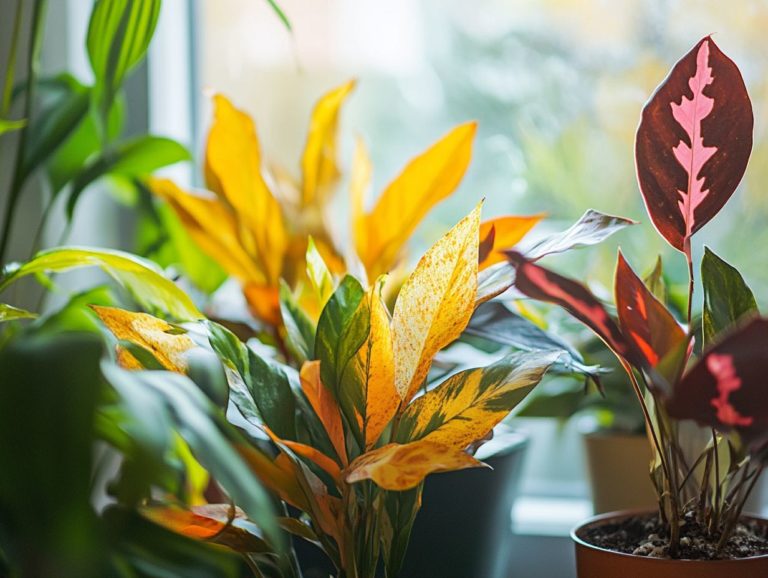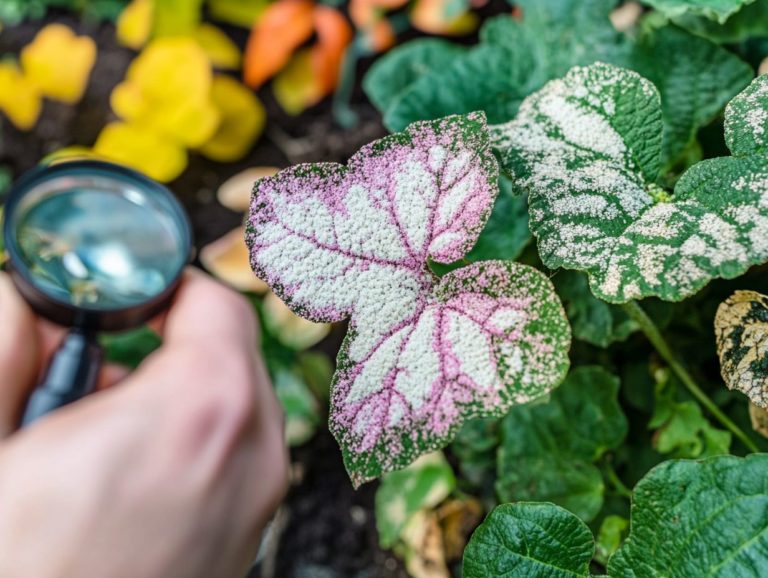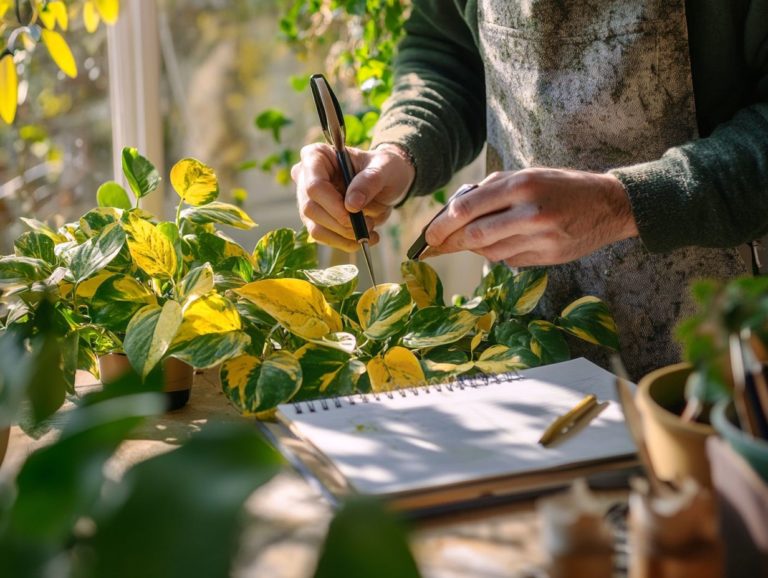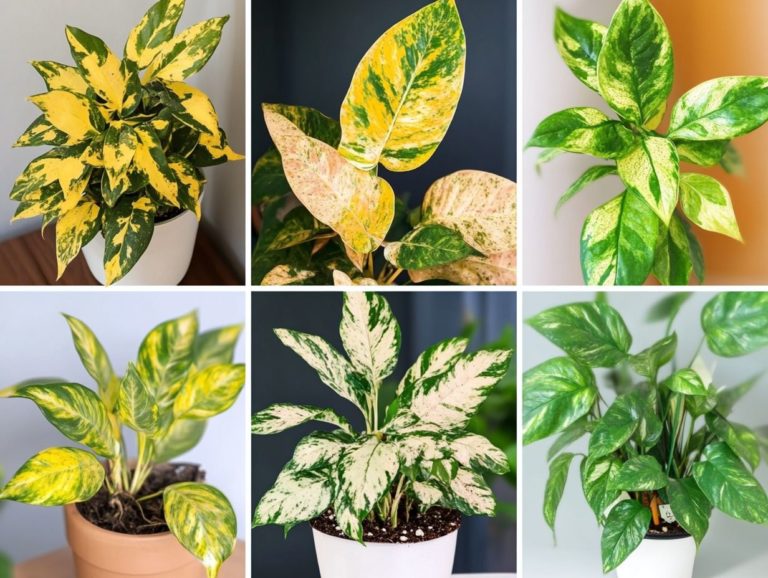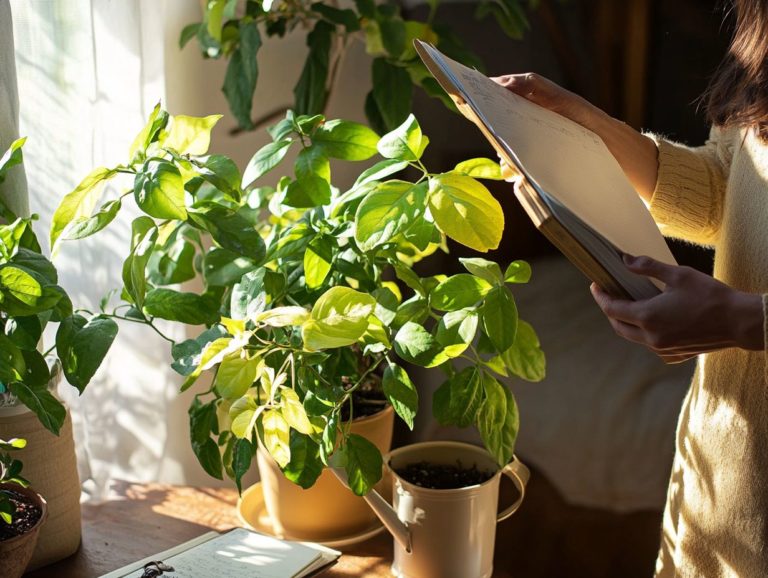Top 10 Signs of a Healthy Indoor Plant
Indoor plants possess the remarkable ability to transform any space, infusing your home with life and vibrancy.
But how can you tell if your leafy companions are truly thriving? Unlock expert gardening tips now and watch your plants thrive!
Here, you ll discover the top 10 signs that reveal your indoor plants are healthy and happy. From lush foliage to steady growth and appropriate watering, recognizing these essential indicators will empower you to nurture your plants effectively.
Ready to level up your plant care skills? Dive into the world of indoor plants!
Contents
- Key Takeaways:
- 1. Lush and Vibrant Leaves
- 2. No Signs of Pests or Diseases
- 3. Steady Growth
- 4. No Yellowing or Browning of Leaves
- 5. Adequate and Balanced Watering
- 6. Appropriate Amount of Sunlight
- 7. Proper Drainage
- 8. No Wilting or Drooping
- 9. No Foul Odors
- 10. No Signs of Overcrowding
- How to Maintain a Healthy Indoor Plant?
- Frequently Asked Questions
Key Takeaways:
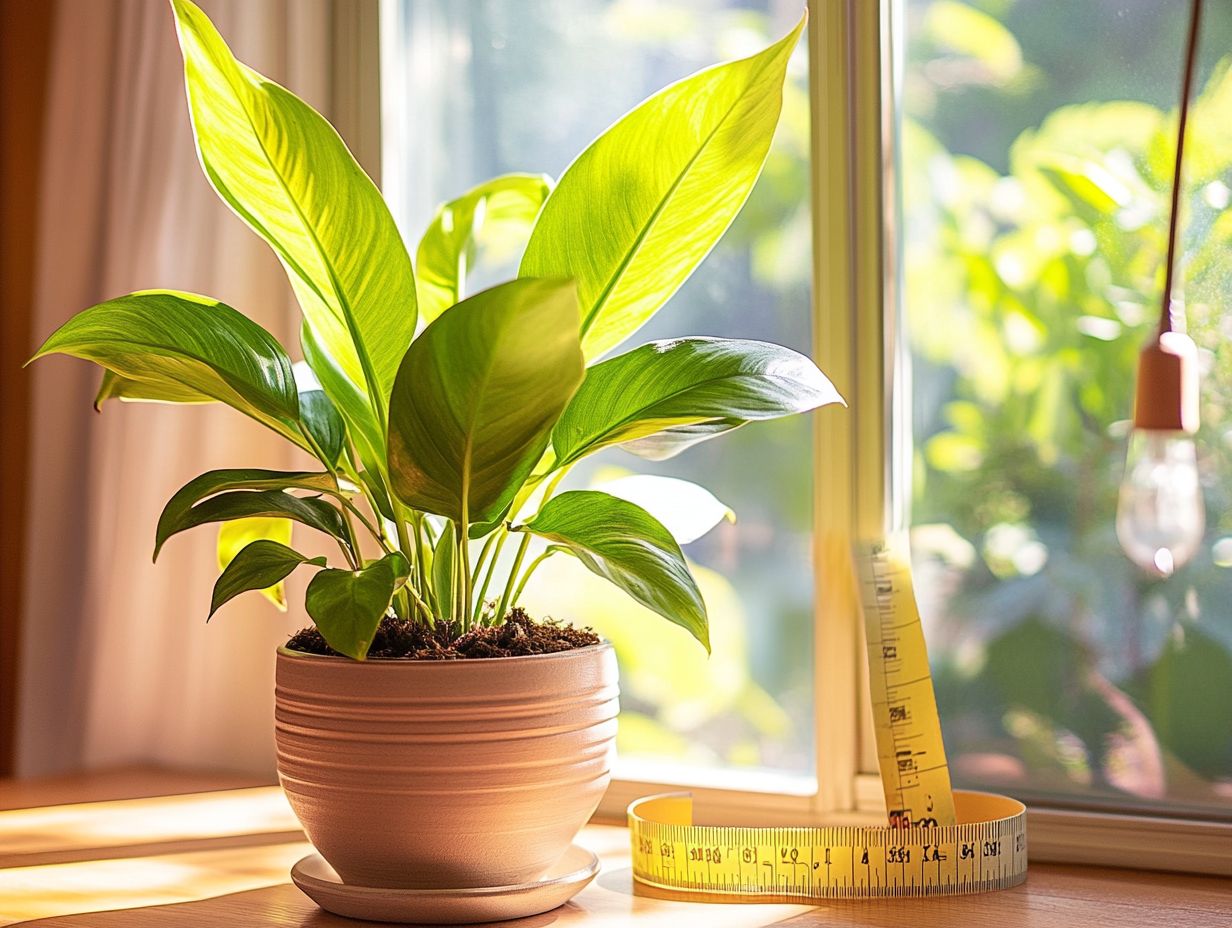
- A healthy indoor plant has lush and vibrant leaves, indicating good overall health.
- Healthy indoor plants keep pests and diseases away, ensuring long-term growth.
- Proper care, including balanced watering and adequate sunlight, is key to a healthy indoor plant.
1. Lush and Vibrant Leaves
Lush and vibrant leaves are the hallmark of thriving houseplants, reflecting their health and the care you provide in terms of light and humidity.
To achieve this, tailor light exposure to each plant s needs, ensuring they bask in just the right amount of brightness without the risk of sunburn. Humidity levels are crucial; tropical plants, for example, flourish in moist environments. Consider using a humidifier or pebble trays to maintain optimal moisture for your green friends.
Healthy soil is equally vital; a nutrient-rich, well-draining soil supports root health and overall plant vigor. Neglecting these care aspects can lead to distressed plants, often showing their discontent through yellowing leaves a classic sign of over- or under-watering.
Experts from Better Homes & Gardens recommend the finger test to assess soil moisture before watering, helping you foster a healthier environment for your botanical companions.
2. No Signs of Pests or Diseases
A healthy indoor plant should exhibit no signs of pests or diseases, as these can impede its growth and overall vitality.
Regular inspections are essential for spotting potential problems early. Staying vigilant allows you to implement effective pest control strategies, including natural remedies like neem oil, a natural pesticide, or diatomaceous earth, while maintaining optimal humidity and ensuring proper drainage.
By recognizing early signs of common plant diseases like yellowing leaves, wilting, or unusual spots you can promote healthier plants. This knowledge enhances your enjoyment of lush greenery and protects your collection from unseen threats.
3. Steady Growth
Steady growth in your houseplants is a clear indicator of their health and vitality, shaped by factors like light sources, temperature stability, and moisture levels.
Monitoring plant growth patterns is crucial for identifying potential issues early and adjusting your care strategies. Consistent practices like adhering to proper watering schedules and using fertilizers rich in essential nutrients nurture this growth.
Providing just the right amount of water neither too little nor too much can prevent stress and promote robust development. Ensuring your plants receive ideal light not only enhances their growth but also encourages lush foliage and vibrant blooms.
By paying close attention to these elements, you can create an environment where your green companions truly flourish.
4. No Yellowing or Browning of Leaves
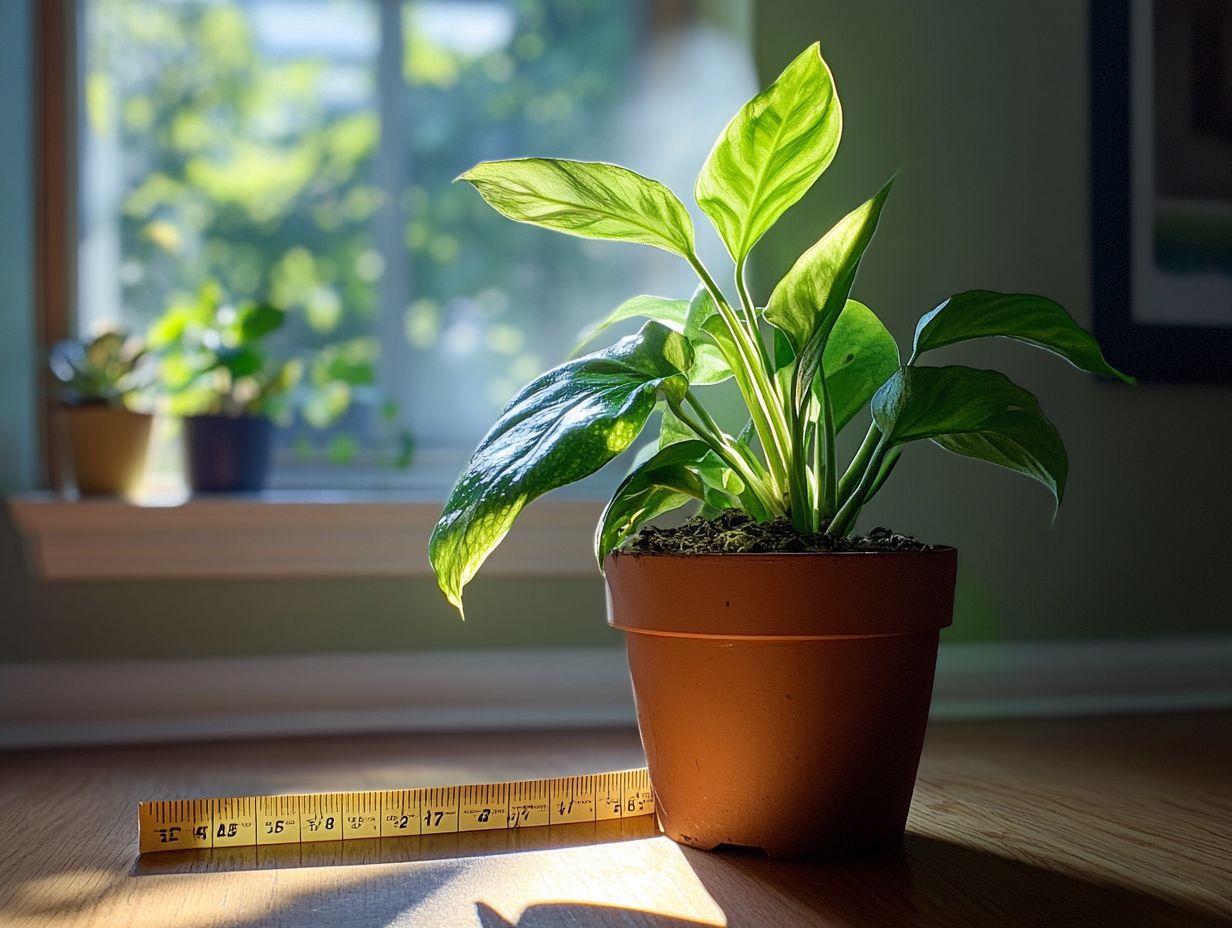
The absence of yellowing or browning leaves in your indoor plants is a clear indicator that you re doing a commendable job with care. It also means the environment is just right for nurturing vibrant greenery.
When you start to notice those telltale signs of distress, like yellowing or browning tips, act quickly! These symptoms often point to underlying issues that need your attention. Overwatering is a frequent offender, leading to root rot and depriving your plants of essential oxygen. If your plants aren t getting enough light, they ll struggle to make their food through sunlight. Pests like spider mites or aphids can also sap a plant s vitality, leaving its leaves lackluster.
To keep these problems at bay, establish a consistent watering schedule and make sure the soil drains well. Position your plants in well-lit areas. Check for pests regularly. Keeping humidity levels right boosts plant health and creates a flourishing indoor environment that you can truly enjoy, filling your space with vibrant greenery.
5. Adequate and Balanced Watering
Adequate and balanced watering is essential for the overall health of your indoor plants. It directly influences soil health and helps prevent issues like root rot and leaf curling.
Understanding that each type of plant has its own unique watering needs is crucial for maintaining a thriving indoor garden. Using moisture meters lets you accurately gauge when it s truly time to water. This reduces the risk of both under- and overwatering. For instance, succulents and cacti thrive in dry conditions, while tropical plants may crave more frequent hydration.
Watch for signs of overwatering like wilting, yellowing leaves, and that unpleasant sour smell from the soil. These signal an urgent need to reassess your watering practices.
Make sure your pots have enough drainage holes. Proper drainage is crucial to prevent excess moisture from accumulating. This allows roots to breathe and absorb nutrients effectively. With these strategies in place, your indoor garden will flourish like never before!
6. Appropriate Amount of Sunlight
Providing the right amount of sunlight is essential for your indoor plants. Different species have unique light requirements that significantly impact their growth and health.
To assess the light conditions in your home, take note of the direction of your windows, the time of day, and the intensity of sunlight that filters through. Bright, south-facing windows typically offer the most light, while north-facing ones create lower light conditions.
Pay close attention to your plants. If you notice them stretching toward a window, it s a clear sign they could use more light. In such cases, consider investing in suitable grow lights to effectively supplement natural sunlight.
Regularly rotating your plants is a smart move, as it allows all sides to receive equal exposure and prevents that awkward asymmetrical growth. Insufficient sunlight can lead to leggy plants, stunted growth, or even leaf drop. Proper placement and lighting are crucial for their overall vitality.
7. Proper Drainage
Proper drainage is essential for your indoor plants. It safeguards against issues like overwatering and root rot, promoting healthy roots and optimal growth.
Make sure your pots have enough drainage holes. Choosing the right potting mix is also critical for effective water management. A well-selected mix enhances aeration (this helps air circulate in the soil) and drains excess moisture, helping you maintain balanced hydration levels for the roots.
Incorporating organic matter, such as compost or coconut coir, can significantly boost soil health by increasing nutrient availability and fostering beneficial microbial activity. Techniques like mulching can also be beneficial. They help retain moisture while minimizing evaporation and allowing for necessary air exchange. This exciting approach will help your plants thrive and flourish!
8. No Wilting or Drooping

Healthy plants have firm, upright leaves. Wilting often means you’re over or under-watering.
When your plants thrive without showing signs of stress, it typically means you’ve got a well-structured watering schedule and humidity control that perfectly suits their needs. Overwatering can lead to root suffocation, while underwatering causes dehydration. Fluctuating humidity can worsen these issues. Dry conditions might sap moisture, while too much moisture could invite diseases.
To avoid these concerning signs, establish consistent watering routines tailored to each plant’s unique requirements. Monitor humidity levels to create a nurturing environment that fosters stable growth.
9. No Foul Odors
Bad smells can mean trouble. They often come from rotting materials or too much moisture.
Identifying unpleasant smells is crucial, as they often arise from dead leaves or stems, overly moist soil, or pesky infestations. Start by inspecting the soil for excessive moisture, which can lead to root rot and those unpleasant odors. Allowing the top inch of soil to dry out before watering again can make a world of difference.
Examine your plants for signs of pests next look for discolored leaves or webbing. If you spot any troublemakers, use solutions like neem oil or insecticidal soap to combat the infestations.
Regularly cleaning the leaves and ensuring proper air circulation will promote a healthier space, ultimately helping you prevent these issues before they even start.
10. No Signs of Overcrowding
Plants need space to grow well. Overcrowding can harm their health.
A healthy indoor space should exhibit no signs of overcrowding, ensuring that each species has the space, light, and resources needed to thrive and reach its full potential. Proper plant selection and strategic spacing are key to achieving this balance. To maintain healthy plants, be aware of the top 5 signs of indoor plant distress. Different species have unique growth requirements, and understanding these nuances helps you prevent competition for nutrients and light.
Choose compatible plants that can coexist harmoniously. Watch for signs that a plant may be outgrowing its home roots pushing through the pot or yellowing leaves can signal a lack of space. Regular pruning will help maintain both shape and health, while repotting into a larger container can provide the necessary room for healthy growth.
How to Maintain a Healthy Indoor Plant?
To keep your plants happy, understand their needs. Each one has its own special care.
From determining the perfect watering schedule to grasping the light requirements, each plant has unique preferences that deserve your attention. Some species bask in bright, indirect sunlight, while others thrive in low-light conditions. Assess their placement in your home accordingly. Humidity levels also play a vital role; tropical plants often relish a more humid environment, so consider misting or using a pebble tray to maintain adequate moisture.
Regular fertilization is key to nourishing your plants, but customize the frequency and type of fertilizer based on the individual needs of each variety. By closely monitoring these factors, you ll create an optimal environment for your indoor plants to thrive and truly shine!
Take these steps to create a thriving indoor garden today!
What Are the Common Causes of Unhealthy Indoor Plants?
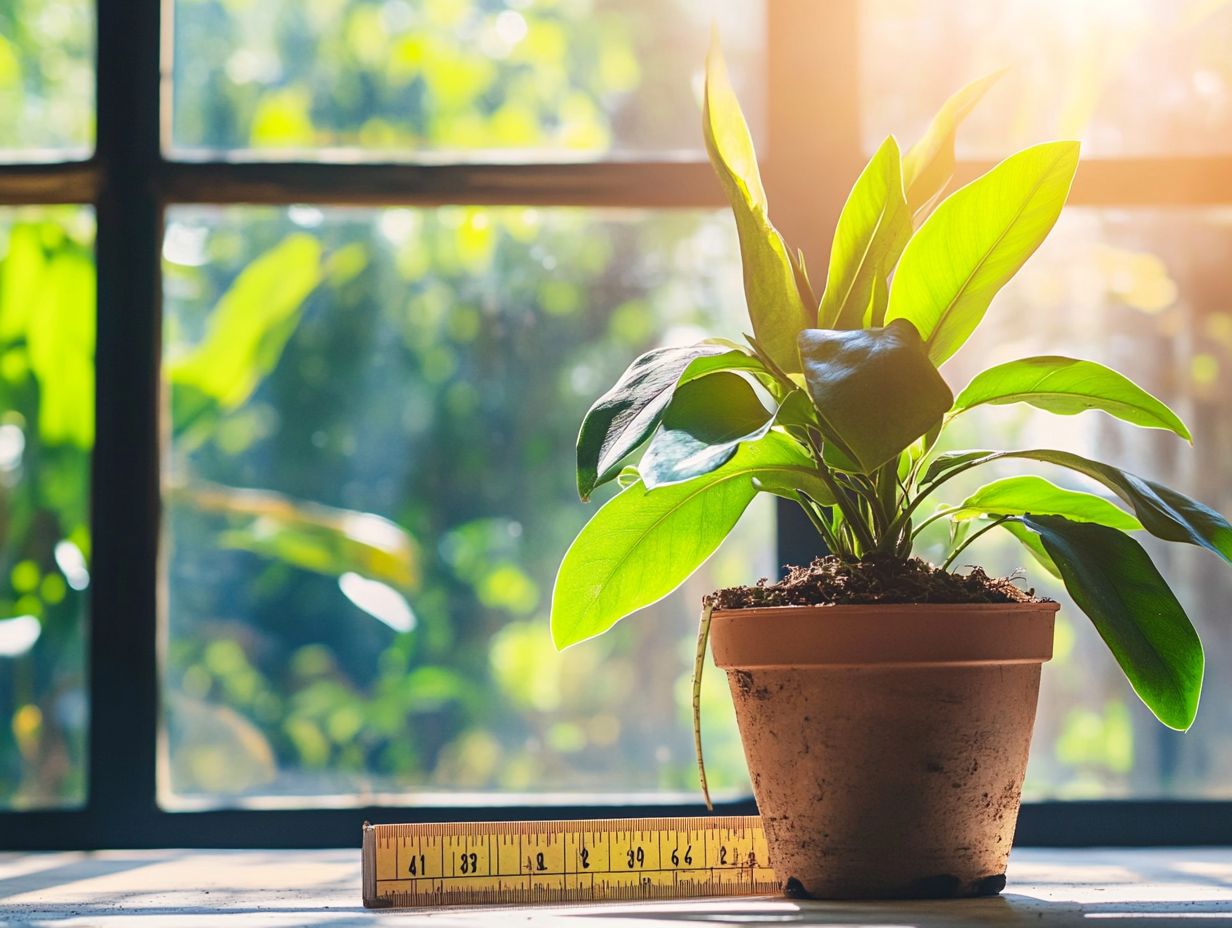
Unhealthy indoor plants often arise from several common culprits, including neglect, improper watering practices, and unsuitable light conditions.
These issues can manifest in various ways, so it s essential to stay vigilant. For example, overwatering can lead to root rot. Insufficient sunlight might result in stunted growth or leggy plants stretching desperately toward the nearest window. Recognizing these signs early is key to preventing long-term damage.
Pest infestations, such as aphids or spider mites, can sap the life from your indoor companions. By familiarizing yourself with these common problems, you can stay one step ahead.
Adjusting your watering schedule, repositioning your plants for optimal light exposure, and implementing effective pest control measures can help your plants thrive again!
How Can One Identify and Treat Common Plant Diseases?
Identifying and addressing common plant diseases is crucial for keeping your indoor garden healthy, as these issues can quickly spread and jeopardize the vitality of your plants.
Understanding the signs of various plant diseases and pest infestations enables timely action. For instance, if you notice yellowing leaves, it may signal overwatering or a nutrient deficiency. A common fungal disease, powdery mildew, appears as a white, dusty coating on your plant’s foliage.
Regular inspections and appropriate treatments are essential. You can use organic fungicides natural substances that combat fungi or insecticidal soaps, which target pests without harming beneficial insects in your garden’s ecosystem.
Implementing preventative measures, such as proper watering techniques, ensuring adequate sunlight exposure, and rotating your plant species, can significantly enhance plant health. This makes them less vulnerable to diseases and infestations.
What Are the Best Practices for Watering Indoor Plants?
Best practices for watering indoor plants are essential for nurturing healthy roots and ensuring optimal soil health, which significantly influences the overall vitality of your indoor greenery.
While watering techniques may differ depending on the type of plant, a good rule of thumb is to check the top inch of soil for dryness before adding water. Water your indoor plants thoroughly, allowing it to seep through the drainage holes at the bottom of the pot.
It s generally advisable to water either early in the morning or late in the afternoon. These times help minimize evaporation and enable your plants to absorb moisture more effectively.
To fine-tune your watering schedule, monitor moisture levels using a simple finger test or a moisture meter. This approach helps prevent overwatering and ensures that your plants receive just the right amount of hydration for optimal growth.
How Can One Ensure Adequate Sunlight for Indoor Plants?
Ensuring that your indoor plants receive adequate sunlight is crucial for their growth, as different species thrive under varying light conditions, ranging from bright to low light.
To accurately assess the light levels in your home, consider investing in a light meter. This device provides precise measurements of light intensity. Alternatively, you can observe how long the sun streams through your windows throughout the day, allowing you to track seasonal changes.
When selecting appropriate light sources for your light-hungry plants, investing in grow lights can be a game-changer. These specialized bulbs mimic sunlight and can be adjusted for both intensity and duration, giving your plants the boost they need.
To maximize sunlight exposure, position your plants near south-facing windows during winter, or use reflective surfaces to enhance light distribution indoors, especially during shorter days.
Start assessing your plants today and give them the care they deserve!
What Are the Different Types of Indoor Plants and Their Care Needs?
Indoor plants offer an impressive array of species, each with different care needs. These range from easy-care plants to tropical varieties that thrive under specific environmental conditions. Understanding these categories is essential for anyone looking to become a plant parent.
Take hardy plants like snake plants and pothos; they flourish on neglect and adapt remarkably well to low light. In contrast, ferns and orchids revel in higher humidity, often benefitting from regular misting and bright, indirect sunlight. If you lean toward succulents and cacti, you’ll find that they prefer dry environments and bright direct light. This makes them ideal for those sun-drenched spots in your home.
Familiarizing yourself with the specific light and humidity needs of various indoor plants allows you to create perfect living conditions that promote their health and longevity. This can turn your home into a vibrant green oasis!
In this video, you’ll learn tips on indoor plant care to keep them healthy and thriving.
Frequently Asked Questions
What are the top 10 signs of a healthy indoor plant?
- Bright and vibrant leaves: Healthy indoor plants have leaves that are deep and rich in color, rather than pale or discolored.
- Strong and sturdy stems: Look for plants with firm and strong stems, as this indicates they are well-nourished and able to support their own weight.
- Lush foliage: A healthy indoor plant will have a full and lush appearance, with no bare or sparse areas.
- No signs of pests: Check for any visible signs of pests such as insects or webs, which can indicate an unhealthy plant.
- Good drainage: Healthy plants need good drainage, so make sure the soil is not waterlogged or overly dry.
- New growth: Look for new leaves or buds forming, as this is a good sign that the plant is thriving and actively growing.
- No wilting or drooping: If your plant’s leaves are drooping or wilting, it may be a sign of over or under watering, which can lead to an unhealthy plant.
- No yellowing or browning: Yellowing or browning leaves can be a sign of nutrient deficiencies or disease, so be sure to inspect your plant for these signs.
- No foul odors: Healthy indoor plants should not have a strong or unpleasant odor, which could be a sign of root rot or other issues.
- Regular pruning: Pruning can help promote healthy growth and ensure your plant maintains its shape and appearance.
Choose your favorite indoor plant today!

